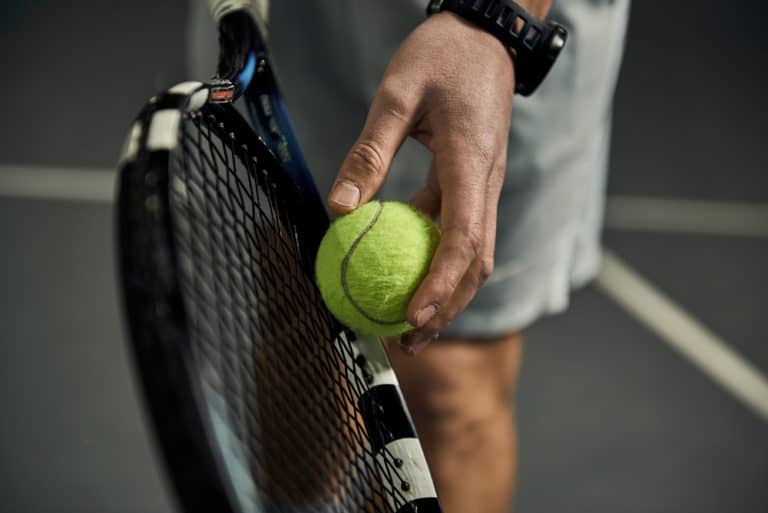How To Fix A Bent Tennis Racket
The smallest change in the structure and frame of a tennis racket can negatively impact your performance in a tennis match. A bent racket frame will reduce the amount of control you have over the ball and affect the power and speed of the ball. Fixing your bent tennis racket may sound easier than replacing it. But is it really?
Tennis rackets made of robust materials like graphite and carbon fiber cannot easily be fixed once the frames have been bent. Aluminum frames can be reshaped using a rubber mallet, depending on how bent the frame is. Bent wooden rackets can be fixed by using steam and a head press.
Tennis rackets can be made of wood, aluminum, graphite, or carbon fiber. Some bent frames may be easier to fix than others. Read on to find out whether you can fix your bent tennis racket and tips on how to go about fixing it.
Do All Types Of Rackets Bend?
Not all types of tennis rackets are prone to bending. The materials that a tennis racket is made of will determine its strength and ability to keep its shape over the long term. The force used to whack a tennis ball places pressure on the strings and the frame of the racket—the stronger the frame, the less chance of bending or warping.
One of the most robust materials used for tennis rackets is graphite. Before carbon-fiber rackets came out, most rackets were made out of graphite or graphite composites, including titanium or Kevlar. Graphite isn’t exceptionally lightweight, but it is strong, stiff, and durable. The racket absorbs the shock from the ball without compromising the frame. The frame’s rigidity also enables the player to hit with more force and precision and is great for doing strong power serves.
Unless they have been very poorly manufactured, you will seldom find a graphite racket bending or warping. This robust material can also withstand external forces like heat or wind better than most materials.
Carbon-fiber rackets are an upgrade from graphite rackets, mainly because they offer the same amount of power but are more lightweight. Carbon-fiber rackets are robust and give the frame a rigidity that makes bending or warping almost impossible.
Before graphite rackets were discovered, most tennis rackets were made out of aluminum. Aluminum rackets are still popular today, primarily due to the unparalleled weightlessness of aluminum. The problem with very lightweight materials is that they are easily damaged, and therefore aluminum rackets are more prone to bending or warping over time. They also do not do well when used outdoors for a long time. Aluminum rackets are best for beginners who do not use as much power and force when playing tennis.
Wooden rackets are completely ancient and are rarely sold or used today. Wooden tennis rackets are not considered strong or durable. They have a smaller frame and very small hitting surface due to the lack of stiffness in the frame. They do not deliver much power either. A wooden frame can easily bend or warp with prolonged use when exposed to external factors like sun or rain. Improper stringing of a wooden racket will also cause it to bend or warp.
What Causes Tennis Rackets To Bend?
As you most probably know, a tennis racket doesn’t just bend by itself. Below we have listed a few factors that can cause a tennis racket to bend or warp.
1. Tennis Racket Bending Due To Improper Stringing
If a racket’s strings are too tight overall or tighter on one side of the racket, this can cause the frame to bend over time, especially if you play tennis with the racket for an extended time. The pull and tension o the strings should be even on all sides of the racket if you want the frame to remain in good shape and have control when hitting the ball. This is especially true with more flexible frames like aluminum or wood that are already more prone to bending than graphite or carbon fiber.
2. Tennis Racket Bending Due To Abuse
It is not uncommon for some frustrated or heavily competitive tennis players to hit their rackets against a wall or on the ground. Of course, if your racket is not robust graphite or carbon fiber racket, then one powerful strike to the ground will result in a bent frame. The way you handle your racket off the court also plays a role. You should handle lighter, more flexible frames with care if you want the racket to last longer.
3. Tennis Racket Bending Due To Playing Technique
It’s an obvious fact that the harder you hit, the more force is exerted on the racket and the more it will bend. This is especially true for professional players that use more force and power when they hit the ball. Naturally, with more flexible frames like aluminum or wood, you can expect some bending or warping with prolonged use.
Another thing to consider is which side of the racket is used more. If a tennis player has a specific grip on the racket and is, for example, prone to playing more forehand than backhand, then one side of the racket will start bending to that side. It is good to alternate your grip or the side of the racket you most often play with to ensure that the frame remains straight.
4. Tennis Racket Bending Due To Structural Failure
Almost everything undergoes some form of wear-and-tear, and the same goes for tennis rackets. The fibers in the racket frame will start to weaken and wear out over time, making the racket much more prone to bending. More robust materials like graphite and carbon fiber can withstand wear-and-tear better than wood and aluminum.
5. Tennis Racket Bending Due To Improper Storage
Storing a tennis racket in a hot car or leaving it in the sun can be detrimental to the frame. The heat will compromise the frame’s structural integrity and distort the frame. Heat can also cause a loss of string tension.
Wooden rackets can also lose shape if left in the sun or the rain for too long. Heat or moisture will alter the wood fibers and cause a bent or warped frame and loose strings.
Can A Bent Tennis Racket Frame Be Fixed?
Unless your tennis racket is made out of wood, then fixing a bent racket is nearly impossible. Most tennis experts suggest buying a new racket rather than trying to fix it. But if you love your racket frame and are desperate to try and fix it, then we suggest you try the following:
1. Re-string The Racket Using A 6pt Stringing Machine
Tennis rackets made out of stiff, robust materials like carbon fiber or graphite do not often bend or warp. Unfortunately, you cannot easily fix them on the rare occasion that they do. However, if the bending is caused by poor string tension, then re-stringing using a 6pt mounting system may solve the problem.
2. Use A Rubber Mallet To Reshape The Racket Frame
If your racket has an aluminum frame, then using a rubber mallet may help you bend it back into its original shape. However, be very careful not to hit the plastic grommets, as these can easily break with force. A rubber mallet may effectively fix a slightly bent racket, but may not work very well on severely bent frames.
3. Use Steam And A Head Press For A Bent Wooden Racket
You can fix a bent wooden racket by steaming the wood or placing the racket in water for some time. First, remove the strings, then put the racket on a flat surface and place a head press on top of it. Allow it to dry, and then afterward, re-string the racket. This technique should help to fix the frame and straighten out the bend.

How To Avoid Your Tennis Racket From Bending
A bent racket negatively affects your gameplay and is challenging to fix. Here are a few tips to prevent your tennis racket from bending:
- Buy the right racket for your skill level. If you’re a professional that has a very powerful swing and serve, then buy a racket robust enough to do the job without bending.
- Make sure your racket is stringed by a professional to avoid incorrect string tension that can lead to bending.
- When playing, use the correct technique to avoid one side of the racket bending more than the other side.
- Keep your rackets stored safely, away from extreme temperatures or external conditions.
- Buy from reputable manufacturers that do not compromise on the quality and durability of the materials used to make their rackets.
References
- https://www.azom.com/article.aspx?ArticleID=1559
- https://www.dummies.com/article/home-auto-hobbies/sports-recreation/tennis/choosing-a-tennis-racquet-200771/
- https://tennisgears.review/graphite-vs-aluminum-tennis-racquet-which-should-you-choose/
- https://www.tennistips.org/do-tennis-racquets-wear-out/
- https://www.usta.com/en/home/improve/gear-up/national/when-is-it-time-for-a-new-tennis-racquet.html
- https://www.reddit.com/r/tennis/comments/bwvy9p/bent_my_racket_is_there_anything_i_can_do_can_i/
- https://tt.tennis-warehouse.com/index.php?threads/once-a-wooden-racket-is-warped.361018/
- https://tt.tennis-warehouse.com/index.php?threads/i-have-a-warped-aluminum-frame-can-i-fix-it.252967/
- https://tt.tennis-warehouse.com/index.php?threads/racket-bending.271293/
- https://tt.tennis-warehouse.com/index.php?threads/bent-racquet.75807/
- https://tt.tennis-warehouse.com/index.php?threads/how-do-racquets-warp.522905/
- https://tt.tennis-warehouse.com/index.php?threads/can-i-de-warp-an-old-wooden-racquet.390680/
- https://www.reddit.com/r/tennis/comments/3hl4o0/my_racquet_is_warped/
- https://www.reddit.com/r/tennis/comments/bwvy9p/bent_my_racket_is_there_anything_i_can_do_can_i/
- https://tennisgears.review/graphite-vs-aluminum-tennis-racquet-which-should-you-choose/
- https://www.quora.com/Do-graphite-tennis-rackets-bend-Are-they-better-as-compared-to-aluminum-rackets
- https://tt.tennis-warehouse.com/index.php?threads/aluminium-racquets.513782/
- https://tt.tennis-warehouse.com/index.php?threads/effects-of-aluminium-on-a-frame-how-bad-is-it.396851/







